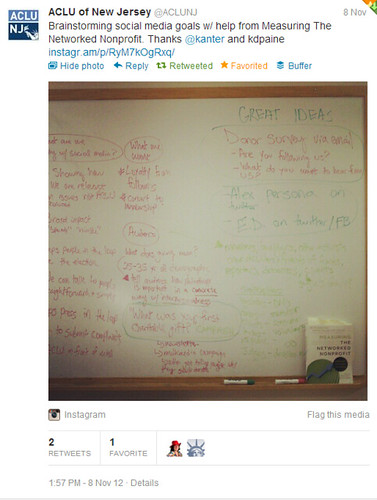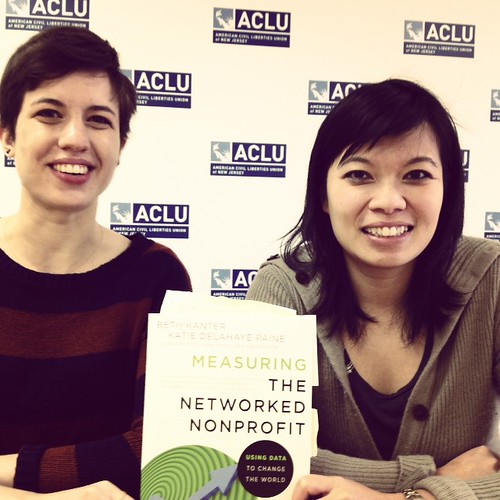
When nonprofits started to read and apply our book, “Measuring the Networked Nonprofit,” I noticed this tweet from the ACLU in NJ showing a white board capturing their team meetings to define success for social media. I followed up with Eliza Straim (Communications Associate) and Katie Wang (Communications Director) to learn more about how they went about this first very important first step for measuring social media – defining results.

Our book introduces nonprofits to the 7 steps of measurement – steps that can be used to measure anything. How did your organization apply it to social media measurement?
Working on the 7 steps of measurement is still an ongoing process for us! While we have articulated our main goal and identified our stakeholders, we are still actively exploring what kind of investment we can make and what various benchmarks mean to us and more importantly what we should do with the numbers we collect. We have realized that without a large budget and stringent privacy restrictions regarding Google analytics, it will take us more time to accomplish the final steps.
Who was at the meeting that led to the white board brainstorm?
Our brainstorming session included our three-member communications team and our Development Director. One of the many important lessons the ACLU-NJ has gleaned from the “The Networked Non-Profit” and “Measuring The Networked Nonprofit” is the benefit of involving outside staff members in communications-related decision making. By involving other staff members in communications-related decisions, we have been able to increase their investment in messaging and the collaboration process has become more dynamic.
What questions did you ask? What prep did you do?
During our brainstorming session we posed such questions as, “What is the point of using social media?” “What are our goals with social media?” “Who is our audience and who do we want them to be?” and “Who are the ACLU-NJ’s stakeholders?” These questions were submitted to the brainstorming team the day beforehand so each person had time to reflect. While each question was discussed at some point during the session, the team also made a concerted effort to not strictly adhere to an outline.
What was easy about defining success? What was hard?
Defining success became easy once the team got over the hurdle of thinking too narrowly. Our first thought was something along the lines of, success means: “3,000 twitter followers by the end of the year” or “A Facebook post with 25 likes.” But once we began to look at the bigger picture, defining success in regards to online engagement became an exciting wish list that after reviewing it seems very possible! Our initial list looked something like this, although the next step is proritize it.
- Cultivate
- Educate
- Convert —> loyalty
- Influence —> take action
- Inspire
- Motivate
- Clarify
- Learn (about followers)
- Share
- Starting Conversations
- Growth organization/membership
What is your measurement pilot?
We haven’t launched a major social media campaign since our brainstorming session but are planning to develop a measurement pilot the next time we execute our semi-annual cartoon caption contest or a Facebook campaign involving one of our legal cases.
What advice would you give to others?
Our main advice to others is to create an environment in which each participant is free to speak candidly and without the fear of going off topic. Once we accomplished this, ideas began to bounce back and forth and a major development/communications multimedia campaign was created! By the time we walked out of the room, we had at least 3 good and easily achievable ideas that we were all very excited about implementing. We will continue to have these brainstorming sessions every few months to focus on best practices for our organization to measure data and to have frank discussions about how social media can help our organization’s mission.
Social Media Presence: ACLUNJ

Define results before you collect data is one of the most important messages in my book, “Measuring the Networked Nonprofit,” co-authored with KD Paine. The first step of measurement is to define the goal, the problem to be solved, or desired return. Without clearly defined outcomes, your organization won’t know what success is and whether social media is returning value.
My colleague, Marion Conway, summarized the annual letter from Bill Gates which focuses on measurement. Here’s how he states it:
“Given a goal, you decide on what key variable you need to change to achieve it-the same way a business picks objectives for inside the company like customer satisfaction-and develop a plan for change and a way of measuring the change. You use the measurement as feedback to make adjustments. I think a lot of efforts fail because they don’t focus on the right measure or they don’t invest enough in doing it accurately.”
Defining goals is not necessarily an easy task and may require several meetings. It requires clearly defined time frames, audiences, and outcomes. It may also take a while to get consensus on objectives in your organization. While specific results will vary depending on your organization’s mission, programs, and intent for social media – and maturity of practice (CWRF). The outcomes you will be measuring will probably include one or more of the following:
- Increase in skills or knowledge of staff
- Change in attitude about your organization
- Change in behavior of target audiences
- Improved engagement with stakeholders
- Improved relationships with donors or volunteers
- Increase awareness
- Increase in action (signing up, downloading, calling, showing up an event, etc)
- Increase the number of volunteers or donors
- Increase the donations or volunteer time
Deciding what to measure is 90% of the process as the ACLU in NJ learned. Getting alignment, that is, getting everyone involved to agree on a pilot project and its measure of success, might be difficult. It needs sufficient time to get buy-in from everyone, especially those who will make decisions based on the measurement data. One technique is after identifying goals, list all your audiences/stakeholders and ask – how likely will they influence the success or failure of getting results? Then ask how having a good relationship with them helps contribute to success.
If you have a large team/organization, you could ask this on a survey and share back the data. Or, have a round of meeting to prioritize what you want to measure. This can be done by writing out all your goals/audiences on whiteboard or flip chart and having folks vote with sticky dots. Or you can make it fun and give everyone play money from a board game and decide how much money they want to invest in each stakeholder group. The one with the most money wins.
Once you’ve prioritized outcomes and audiences, the next step is to biol it down into a simple measurement pilot where pick specific metrics to collect to figure out if you have reached your goals along the way and apply the data to better decision-making as Gates describes in his annual letter. Don’t try to measure everything and pick something that is an easy win for the first time. Remember, you’re trying to build a good habit of measurement and using the data – so more is less.
How does your organization define success and stakeholders for your social media efforts? What types of measurement pilots are you doing?

Leave a Reply